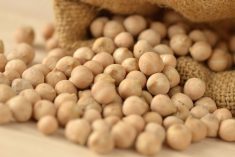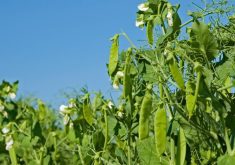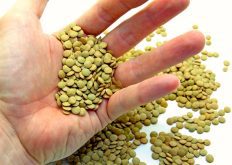CNS Canada –– Canadian chickpeas have a long season to go, but so far the crops look like they’re in it for the long haul.
“We have a fair amount of chickpeas in and they look phenomenal, they’re in full flower and looking as healthy and as good as a chickpea crop can at this stage,” said Colin Young of Midwest Investments at Moose Jaw, Sask.
Unlike lentils, which due to an early start are looking at an early harvest, chickpeas have a much longer life span, Young said.
Read Also

Pulse Weekly: Tariffs guide yellow peas in 2025
Tariffs were a major influence on Canadian yellow pea prices in 2025, with levies imposed by China and India. The two countries are Canada’s biggest foreign pulse buyers.
“As long as there is moisture reserves for (chickpeas) to draw from they will continue flowering and podding indefinitely,” Young said.
“Because of the excellent moisture reserves in the chickpea area, I feel they are going to keep growing… which is good for yield and production.”
The first half of the season is showing average to above-average quantities, Young said. With harvests expected to start mid-September to early October, the quality of the chickpeas is still up in the air.
“The quality side of the chickpea production in Canada is always something you hold your breath on… they require 120 frost-free days to mature properly,” Young said. “September tells the tale of the chickpeas; it’s 100 per cent dependent on the weather.”
So far, Canada’s weather has been good to the Canadian chickpea, which two years ago locals in the industry were advising farmers against planting, Young said.
“The market has been robust and it’s been really great to watch… Canadian chickpeas have an identity again, (they) are preferred over other origins, and now that there is a consistent supplier of Canadian chickpeas, there’s excellent markets and movement for farmers,” Young said. “We are very proud of what we’ve been able to accomplish in two years.”
Large-calibre kabuli chickpeas are priced at 54 cents per pound, while desi chickpeas are priced lower at 31 cents per pound, according to Prairie Ag Hotwire.
— Erin DeBooy writes for Commodity News Service Canada, a Winnipeg company specializing in grain and commodity market reporting.















